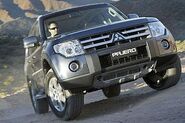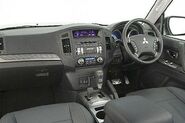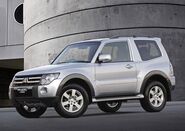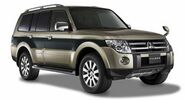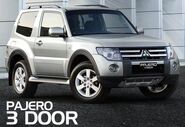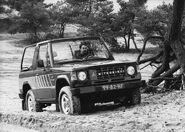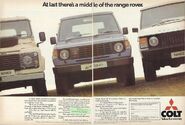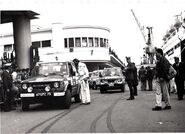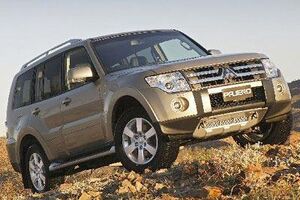
| |
| Mitsubishi Pajero | |
|---|---|
| Mitsubishi | |
| aka | Mitsubishi Montero
Mitsubishi Shogun |
| Production | 1982-present |
| Class | Mid-size 4X4 SUV |
| Body Style | SWB(3 dr Hardtop),LWB(5 dr 7 seat Wagon) |
| Length | 4830 kg |
| Width | 2050 mm |
| Height | 1885 mm |
| Wheelbase | 2780 mm |
| Weight | |
| Transmission | 5 speed Manual 5 speed Automatic |
| Engine | 3.2L Turbo Diesel 3.8L 6G75 V6 |
| Power | |
| Similar | Toyota Land Cruiser Nissan Patrol Hyundai Terracan SsangYong Rexton |
| Designer | |
The Mitsubishi Pajero is a 4x4 SUV made by Mitsubishi.
Recent Changes[]
Mention any minor facelifts or major changes made to the vehicle here.
Styles and Major Options[]
Certain vehicles come in different trim levels or body styles. Features and major options should be mentioned here.
Australasian Market[]
GLS
- 6G75engine
- 5 speed Automatic with Sports Mode
- Dual front airbags
- Front side airbags
- Curtain airbags
- 7 seats
- MATT Mitsubishi All Terrain Technology
- Front and rear air conditioning
- Super select 4WD II
- In-dash 6 disc CD stacker/MP3 and 6 speakers
- 17 inch alloy wheels
- Cruise control
- ABS
- Metallic/pearlescent paint
Pricing[]
Add more fields as necessary.
|
MODEL Trims |
|||
|
Trim1 |
Trim2 |
Trim3 |
Trim4 |
|
MSRP |
|||
|
$Price1 |
$Price2 |
$Price3 |
$Price4 |
|
Invoice |
|||
|
$Price1 |
$Price2 |
$Price3 |
$Price4 |
Gas Mileage[]
Add more fields as necessary.
As seen on the FuelEconomy.gov website, the City/Highway MPG averages are as follows:
|
Trim |
|||
|
Trim1 |
Trim2 |
Trim3 |
Trim4 |
|
MPG |
|||
|
c/h |
c/h |
c/h |
c/h |
Reliability[]
Warranty
5 year/130,000 km
Service interval
10,000/6 months
Safety[]
When the 2004 Mitsubishi Pajero was crash tested by ANCAP, it earned a score of 4 stars. [1]
Photos[]
Colors[]
black red blue are t
Main Competitors[]
Create links to other <MAKE> <MODEL> pages in this section.
Hybrid Models[]
If there are hybrid versions of this vehicle manufactured, then please elaborate a little bit on it here.
Unique Attributes[]
If there are any features of this vehicle that sets it apart from other vehicles in its class, then mention those unique attributes here.
Resale Values[]
Add more fields as necessary.
|
<MODEL> Year |
|||
|
Year X |
Year X-2 |
Year X-3 |
Year X-4 |
|
Resale Value |
|||
|
$ |
$ |
$ |
$ |
Criticisms[]
Please make sure to keep critiques in a third-person point of view. If using criticisms from a reputable automotive source, then please make sure to cite the quote.
Generations[]
Fill in as many as appropriate. Add more if necessary and pictures wherever applicable.
Please make sure NOT to use copyrighted pictures.
The first Pajero prototype was unveiled at the Tokyo Motor Show in November 1973. The Pajero II prototype followed in 1978, five years later. Mitsubishi’s aim was to create more of a recreational vehicle, not just an SUV.
In January 1983, the first Pajero made its debut at the Paris Dakar Rally, taking first place in 1985 at only the third attempt. To date, the Pajero is the most successful vehicle in the Dakar Rally. This not only gave the Pajero an offroad reputation, but also helped in the sales department.
Worldwide[]
If the vehicle is sold in other markets worldwide, then this is the section to mention that information. Also, mention if the <MODEL> goes by another name in these other markets.
First generation (1982–90)
First generation Production 1982–1991 Engine(s) 3.0 L 143 hp (107 kW) V6 2.6 L 109 hp (81 kW) I4 2.0 TD I4 2.3 D I4 2.3 TD I4 2.5 TD I4 Transmission(s) 4-speed automatic 5-speed manual Wheelbase 2,695 mm (106.1 in) (LWB) 2,350 mm (92.5 in) (SWB) Length 4,650 mm (183.1 in) (LWB) 3,995 mm (157.3 in) (SWB) Width 1,680 mm (66.1 in) Height 1,890 mm (74.4 in) (LWB) 1,850 mm (72.8 in) (SWB) Fuel capacity 90 L (19.8 imp gal; 23.8 US gal) (LWB) 60 L (13.2 imp gal; 15.9 US gal) (SWB) Related Dodge Raider The first generation made its debut at the Tokyo Motor Show in October 1981, and was launched in May 1982. Initially, it was a three-door, short-wheelbase model available with a metal or canvas top and three different engines options:
2.0-litre 4-cylinder petrol (2000/2.0) 2.6-litre 4-cylinder petrol (Astron 2.6) 2.3-litre naturally aspirated diesel (2300 D) 2.5 liter turbocharged diesel (2500 TD/2.5 TD). 3.0 liter V6 petrol (3000/3.0). It was loaded with features that had previously not been seen on a Japanese four-wheel-drive car: a turbocharged diesel engine, a front double wishbone suspension with torsion bar springs, power steering and suspension seats. This made the Pajero a four wheel drive vehicle which integrated all the amenities of a passenger car.
In January 1983, only a year following its launch, mildly tuned production Pajeros entered the world of motor sport.
The Pajero, however, failed to appeal to everyone. It was seen to be a commercial vehicle, and since it was only available in a short wheel base form, it didn’t really appeal to those with families.
Hence, in February 1983, Mitsubishi came out with a long wheel base, five door model, to serve the needs of a larger target market. The long wheel base model was available with a choice of two different engines; a 2.0-litre turbocharged petrol (badged as "2.0 Turbo" and "2000 Turbo" in some markets) and a 2.3 liter turbocharged diesel (badged as 2.3 TD or 2300 TD). It also came in Standard, Semi-High Roof and High Roof body styles. A stripped down nine-seater version of the High-Roof variant was commonly used in UN Peace Operations.
The long wheelbase model also increased seating capacity to seven, with available third row seats, which could be folded to the sides for additional trunk space or combined with second row seats to form a bed.
The Pajero was further refined in June 1984. The turbo diesel engines now had higher power/torque ratings, whilst the long wheel base models got standard four wheel disc brakes and four way adjustable shock absorbers as standard equipment.
A new flagship model was then introduced in early 1987, with a two-tone paintjob, fifteen inch (38 cm) light alloy wheels, front seat heaters, wool seat covers, genuine leather headrests, a three spoke steering wheel and a sound system with radio/cassette. Also in 1987, a version of the Pajero/Montero was rebadged by Dodge as the Raider, which ran through 1989.
Mitsubishi Montero LS 4-door (US)Finally in 1988, a 3.0-litre SOHC V6 engine was made available, alongside a 2.5-litre turbo diesel engine, with the first 4x4 intercooler. This translated to better acceleration in mid to high rev ranges. The long wheel base models got a coil link suspension system for better ride comfort and off-road ability.
It was available with a 3-door body for a short wheelbase (SWB) or a 5-door body for a long wheelbase (LWB). Engines included a 2.6 L I4 with 82 kW (110 hp/112 PS), a 3.0 L V6 with EFI and 104 kW (139 hp/141 PS) and a turbocharged 2.5 L OHV diesel I4 with 62 kW (83 hp/84 PS) or an intercooled 70 kW (94 hp/95 PS). Part-time four wheel drive was standard on all models.
The Gen I platform was later built under license by Hyundai Precision Products as the Hyundai Galloper from 1991 to 2003, and exported to Europe for a brief time. While it used first generation mechanicals, the Galloper's body was closer to the second generation Pajeros.
Second generation (1991–1999)
Second generation Production 1991–1999 Engine(s) 4D56 2.5 TD 4M40 2.8L TD 4G64 2.4L I4 6G72 3.0L V6 6G74 3.5 V6 Transmission(s) 5-speed manual 4-speed auto Wheelbase 2,725 mm (107.3 in) (LWB) 2,420 mm (95.3 in) (SWB) Length 4,705 mm (185.2 in) (LWB) 4,030 mm (158.7 in) (SWB) Width 1,695 mm (66.7 in) Height 1,875 mm (73.8 in) (LWB) 1,850 mm (72.8 in) (SWB) Fuel capacity 90 L (19.8 imp gal; 23.8 US gal) (LWB) 75 L (16.5 imp gal; 19.8 US gal) (SWB) Mitsubishi sold over three hundred thousand Pajeros in 1989 and 1990[citation needed]. However, the time for a redesign was long due and 1991 saw the first Generation II Pajero. Just about everything was now new and further enhanced. A new, larger body was available in four different versions; Metal Top, Canvas Top Convertible, Semi High Roof Wagon and High Roof Wagon (long wheel base). The short wheel base models were stretched by 70 millimeters (2.8 inches) and the long wheel base models by 30 millimeters (1.2 inches). The available engines included a 3.0 liter 12-valve SOHC with ECI-Multi electronic fuel injection and a 2.5 liter turbocharged diesel engine with an intercooler.
The second generation also saw the introduction of Super Select 4WD (SS4) [known as ActivTrak 4WD in some markets] and multimode ABS, which were firsts on Japanese four wheel drives. SS4 was ground-breaking in the sense that it combined the advantages of part time and fulltime four wheel drive with four available options: 2H (high range rear wheel drive), 4H (high range fulltime four wheel drive), 4HLc (high range four wheel drive with locked center differential and 4LLc (low range four wheel drive with locked center differential). Another advantage of this second generation system is that it gave the driver the ability to switch between two wheel drive and fulltime four wheel drive at speeds up to 100 km/h (62 mph), whereas the first generation Pajero had to be stationary to switch from rear wheel drive to four wheel drive (but not from four wheel drive back to rear wheel drive). Multimode ABS, on the other hand, was equally innovative. This meant ABS would be fully functional in all modes of SS4, as braking with a locked center differential requires completely different braking parameters.
In July 1993, two new power plants were introduced; a 3.5 liter 24-valve DOHC with ECI-Multi and a 2.8 liter turbocharged diesel with an intercooler. A new, larger transmission and transfer case was also part of the upgrade.
Pajero Evolution (retail version)The Pajero Evolution was introduced in October 1997, which was developed in response to new entry requirements for the Paris – Dakar Rally’s T3 Class. The Pajero Evolution came standard with a 3.5 liter 24-valve DOHC V6 with Mitsubishi Innovative Valve Timing and Electronic Lift Control (MIVEC). A new, dual plenum variable intake helped increase power and a new suspension made the ride even smoother.
SWB and LWB models available in GCC Countries.In 1998, vehicles destined for General Export and the GCC (Gulf Cooperation Council Countries) received a facelift. Wider fenders, new headlights, grille, bumper, fog lights and sidesteps were all part of the redesign. The wide fenders are often called "blister flare fenders". Driver and front passenger SRS airbags were made standard on models equipped with the 3.5 liter DOHC V6 engine, whilst still remaining optional on GLS models with the 3.0 liter SOHC V6. An upgraded interior wood trim was made available on 3.0 liter GLS and 3.5 liter models. A leather-wrapped or leather and wood trim steering wheel was also made available, alongside an upgraded suspension and steering system. The 3.0 liter 12-valve SOHC engine was now available with a 24-valve configuration. Models without wide fenders remained as base models (GLX), available with a 2.4 liter 16-valve DOHC engine, producing 147 hp (110 kW). The 3.0 liter 12-valve engine was optional on these GLX models, and remained the base engine on the GLS.
The second generation was introduced on January 22, 1991 and manufactured until 1999. It retained the two body styles, but design was rounder and more city-friendly than the previous bulky model. The 3.0 L V6 gasoline engine was retained, now available with a 24-valve head, capable of 136 kW (183 hp/185 PS), while the 2.5 turbodiesel's power was slightly increased to 73 kW (98 hp/99 PS). In 1993, the Pajero was slightly restyled, and larger engines were introduced, a 3.5 L V6 with 153 kW (205 hp/208 PS) and a 2.8 L SOHC turbodiesel rated at 92 kW (123 hp/125 PS). These versions introduced Mitsubishi's Super Select four wheel drive system (known as Active-Trac in the United States), with an electronic transfer shift that could split power between both axles without the need to stop the car. It worked at speeds up to 100 km/h (62 mph).
The first generation Pajero was also marketed as the Hyundai Galloper in Korea, Europe and GCC Countries, while the second generation was in production elsewhere.
This model remains in production in India, whereas the latest generation is sold there as the Montero. And in the Philippines as the Pajero 2.8 Field Master 4x2 alongside with the 4th Generation Pajero. 4X4 Pajero is on production until 1999. It is known to be the only one of its kind among Pajeros worldwide to delete the Super Select 4WD drivetrain. This was accomplished in the year 2000 to avoid taxes slapped on 4 Wheel Drive SUVs imposed by the Estrada Administration. It is still in production in Colombia, with CKD parts (Complete Knock Down), with 2.4l 16 valve SOCH(130PS)and 3.0l 12 valve (148PS) , these engines are available only in hard top 3-door and the 5-door only with the 3.0l engine.
Third generation (1999–2006)
Third generation Production 1999–2006 Engine(s) 4D56 2.5 TD 4M41 3.2 Di-D 6G72 3.0 V6 6G74 3.5 V6 6G74 3.5 V6 GDI 6G75 3.8 V6 Transmission(s) 5-speed manual 4-speed auto 5-speed auto Wheelbase 2,780 mm (109.4 in) (LWB) 2,545 mm (100.2 in) (SWB) Length 4,800 mm (189.0 in) (LWB) 4,220 mm (166.1 in) (SWB) Width 1,875 mm (73.8 in) Height 1,855 mm (73.0 in) (LWB) 1,845 mm (72.6 in)(SWB) Fuel capacity 89 L (19.6 imp gal; 23.5 US gal) (LWB) 71 L (15.6 imp gal; 18.8 US gal) (SWB) Designer Pininfarina Designed by Pininfarina, the third generation Pajero hit the Japanese Domestic Market in 1999, whilst it was made available to other markets in late 2000 as a 2001 model. The vehicle was completely redesigned, inside and out and had a lower, wider stance. A lower center of gravity meant the Pajero had better on-road handling manners and the newer body had over three hundred percent more torsional rigidity. The biggest change to bring this about was that the Pajero utilized a unibody construction, as opposed to the previous body-on-frame (box-ladder). This also permitted a longer suspension stroke. The fuel tank was also relocated to between the axles for better safety.
The SS4 system was also further refined, as bevel gears were replaced with planetary ones. This meant the front-to-rear torque setting ranged from 33 to 67, with the ability to adjust to 50/50 depending on surface conditions. The system was also made fully electronic, which meant the vehicle didn’t have to be in gear to switch between drive modes. After all the upgrades, the system was renamed to Super Select 4WD II (SS4-II).
Alongside rack and pinion steering (as opposed to the recirculating ball system on previous generations), the Pajero also offered a choice of three transmissions; a five speed manual, a four speed INVECS-II automatic and a five speed INVECS-II tiptronic.
An all-new 3.8 Liter SOHC 24-valve V6 powerplant was also introduced on this generation. This engine utilized an Electronic Throttle Valve (ETV), to deliver a refined cruising power with power to spare for offroad ventures.
The third generation was introduced on August 2, 1999 and was scheduled to be replaced by the Autumn of 2006, having been restyled in 2003. This was the most luxurious of the three generations, moving to a more upscale segment to compete against the Land Rover Discovery, but more importantly, to counter its home rival Toyota Land Cruiser's growth. The 3.0 L engine's power was decreased to 130 kW (175 hp/177 PS), and the 3.5 L engine was given gasoline direct injection, increasing power to 162 kW (217 hp/220 PS) in the Japanese market (export versions kept the standard EFI engine, now with 149 kW (200 hp/203 PS). The 2.8 L Diesel was retained only for developing markets, and was replaced by a new 16-valve direct injection engine, with 3.2 L and 120 kW (161 hp/163 PS).
In the North American market, the 3.5 L engine was replaced for 2003 by a more powerful 3.8 L unit, with 160 kW (215 hp/218 PS). This engine was later made available to a few export markets such as South America and Australia, whilst it replaced the GDI V6 in the Japanese lineup in 2005. The short wheelbase model is not available in North America, where the Montero is the only SUV in Mitsubishi's lineup with standard four wheel drive. Faced with falling sales, the Montero was pulled from the US market after the 2006 model year.
2001-02 US-spec Mitsubishi Montero
2003-06 US-spec Mitsubishi Montero 2006-2007 Mitsubishi Pajero VRX (Australia)
Fourth generation (2006) Fourth generation Production 2006–current Engine(s) 4M41 3.2 Di-D 6G72 3.0 V6 6G75 3.8 V6 Transmission(s) 5-speed manual 4-speed auto 5-speed auto Wheelbase 2,780 mm (109.4 in) (LWB) 2,545 mm (100.2 in) (SWB) Length 4,900 mm (192.9 in) (LWB) 4,385 mm (172.6 in) (SWB) Width 1,875 mm (73.8 in) Height 1,900 mm (74.8 in) (LWB) 1,880 mm (74.0 in) (SWB) Fuel capacity 89 L (19.6 imp gal; 23.5 US gal
Design quirks and oddities[]
A Mitsubishi Pajero was used as a support vehicle in a feature documentary Long Way Round along with a Triton in 2005. It was replaced by a Ford Excursion for the rest of the journey.
Awards[]
List out notable awards that the model has recieved while in production. Boldface the company or orgainization that gives out the award, and Italicize the name of the award.
See also[]
External Links[]
Please include any external sites that were used in collaborating this data, including manufacturer sites, in this section.
